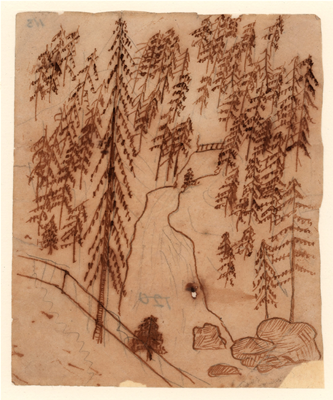
Mountain scenery with coniferous forest and river Le Locle 1833. Kilde: Odense Bys Museer
Shadow pictures of a journey
But now for the author’s drawings! A rich collection of them has been preserved in H. C. Andersens Hus at Odense. It was chiefly in the early years that Andersen drew avidly, and for the most part on his journeys in the period 1831 1841 which resulted in works such as Shadow Pictures of a Journey to the Harz Mountains, etc, in the Summer af 1831 (1831), The Improvisatore (1835) and A Poet’s Bazaar (1842). His enthusiasm for the foreign parts which he visited, and not least for the beauty of Italy , seem also to have inspired him to creativity as agraphic artist. To Andersen’s art as a writer, the immediate sensation and fresh observation are basic. His small drawings, executed direct from the subject with a quill or reed pen, fixes his experience like a vivid manuscript. They would later support his vision as a writer. We see from his diaries, letters, travel descriptions and novels, as indeed from many of the fairy tales, that it was important to him to recollect things seen. Everywhere we feel the closeness in his relationship with nature. When he describes a landscape that has impressed him one not infrequently feels that he experiences nature with all his senses at once, almost as if through a short-circuiting of intense emotional and poetic experience. Yet it is clear that the lucidity of his writing depends predominantly on his matchlessly clear visual experience of things.